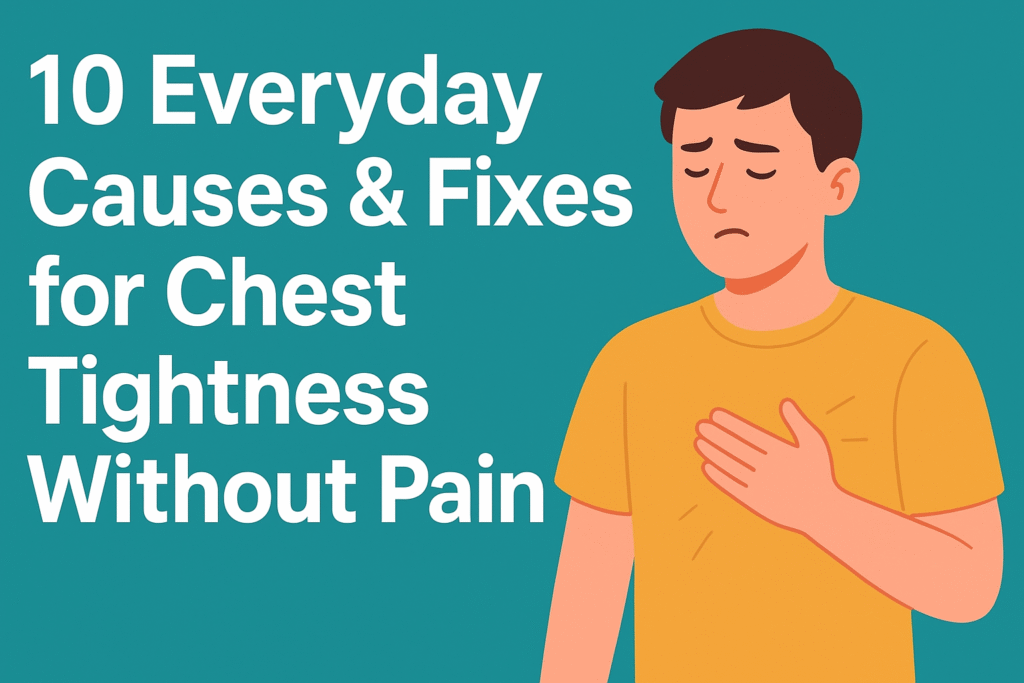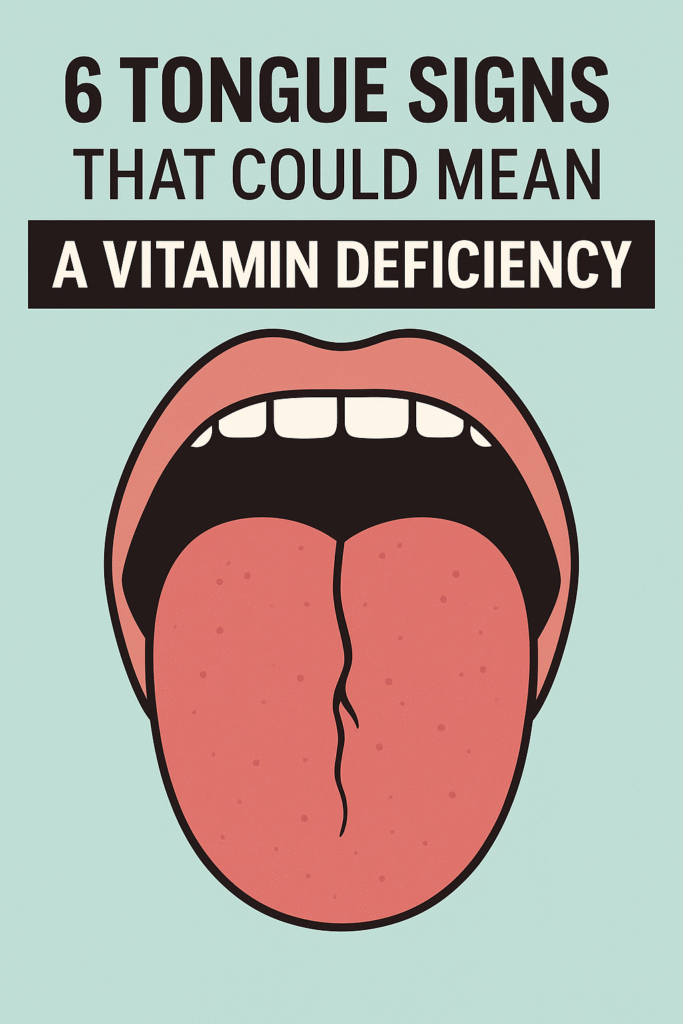
⚠️ Affiliate Disclaimer: This post may contain affiliate links, which means I may earn a small commission — at no extra cost to you — if you make a purchase through one of these links. I only recommend products or services I genuinely trust and believe can provide value. Thank you for supporting My Medical Muse!
Chest Tightness Without Pain: 10 Powerful Causes & Fixes
Why Does My Chest Feel Tight but No Pain? Everyday Causes & Fixes
Chest tightness can be one of the most unsettling sensations you can experience when most people notice something unusual in their chest, the first thought often jumps straight to the heart and understandably so, but what if your chest feels tight without actual pain?
The absence of sharp or severe pain doesn’t mean you should ignore the sensation, but it also doesn’t always signal something dangerous. In fact, many everyday, non-life-threatening reasons could explain why your chest feels heavy, constricted, or “tight.”
This guide will walk you through:
- The most common everyday causes of chest tightness without pain
- How to identify possible triggers in your own life
- Natural and medical fixes to ease the discomfort
- Warning signs that indicate when to seek urgent medical care
- Practical lifestyle strategies to prevent recurrence
What Does Chest Tightness Actually Feel Like?
Chest tightness can mean different things to different people, for some, it feels like a band of pressure squeezing around the chest. Others describe it as an inability to take a full, satisfying breath. Common sensations include:
- A band-like pressure wrapping across the chest.
- Trouble expanding the lungs fully or taking a deep breath.
- A heavy or weighed down feeling on the chest wall
- A mild squeezing sensation without sharp or stabbing pain.
- The frustrating sense that you need to yawn or sigh but can’t quite manage it
Unlike chest pain, which is often sharp, stabbing, or burning, tightness is usually dull, pressing, and more about restriction than acute pain. Understanding this distinction is helpful when trying to figure out what’s really going on.
Everyday Causes of Chest Tightness Without Pain
While certain causes are medical and require prompt attention, many instances are linked to lifestyle habits, posture, or stress. Let’s start with one of the most common triggers.
1. Anxiety and Stress
Modern life puts a lot of pressure on the body and mind, and your chest often reflects that. Stress and anxiety are leading causes of chest tightness without pain, affecting millions of people worldwide.
When you’re anxious, your body shifts into fight or flight mode, releasing adrenaline and cortisol. These stress hormones prepare you to deal with perceived danger, but they also trigger physical reactions, such as:
- Rapid breathing (sometimes shallow or uneven)
- Increased heart rate and awareness of heartbeat
- Muscle tension, especially in the chest wall and diaphragm
- Sweaty palms or trembling, as the nervous system kicks into overdrive
This combination can make your chest feel tight, heavy, or restricted, even if your heart and lungs are healthy.
Why Anxiety Chest Tightness Feels So Alarming
Anxiety-induced chest tightness is so common that many people mistake panic attacks for heart attacks. The sensations can overlap, but there are some differences. Panic-related chest tightness often comes with:
- Sweating that starts suddenly, even in cool environments
- Trembling or shaking
- Dizziness or lightheadedness, often from hyperventilation
- A sudden overwhelming sense of fear or doom, which doesn’t usually occur with heart-related chest discomfort
While anxiety doesn’t damage your heart directly, repeated episodes of stress can wear down your body over time. That’s why managing anxiety isn’t just about mental health, it’s also important for physical well-being.
Everyday Triggers That Can Lead to Anxiety-Related Tightness
- Work deadlines, exams, or financial stress
- Excess caffeine or energy drinks.
- Lack of sleep or poor-quality rest.
- Arguments, conflicts, or emotional tension.
- Overthinking or constant worrying.
How to Relieve Stress-Induced Chest Tightness
- Breathing exercises (slow, deep breaths calm your nervous system),
- Grounding techniques (focusing on your senses to bring your mind back to the present).
- Light movement such as stretching, yoga, or walking.
- Limiting stimulants like coffee, nicotine, or sugary drinks.
- Mindfulness or meditation to break the cycle of anxious thought patterns.
The good news? Once anxiety is addressed, the chest tightness often fades within minutes to hours.
2. Poor Posture
Spending long hours hunched over a desk, scrolling on your phone, or working on a laptop can gradually reshape your posture. When your shoulders roll forward and your upper back curves, the chest muscles shorten while the back and spine-supporting muscles weaken. This imbalance creates:
- A feeling of restriction across the chest.
- Difficulty expanding the ribcage fully during deep breaths.
- A sense of heaviness or “compression” when breathing.
Even something as simple as slouching on the couch for hours can mimic the sensation of chest tightness. Over time, poor posture doesn’t just make breathing feel harder, it can also contribute to muscle fatigue, shallow breathing, and even anxiety-like symptoms.
Practice posture resets throughout the day. Roll your shoulders back, lift your chest, and take a few slow deep breaths every hour. A standing desk or ergonomic chair can also help reduce the strain.
3. Muscle Tension or Fatigue
The chest wall isn’t just bone, it’s made of muscles that expand and contract every time you breathe. Overuse or strain in these muscles can easily create a feeling of tightness without sharp pain. Common culprits include:
- Heavy lifting at the gym or work.
- Carrying groceries, backpacks, or children.
- Intense workouts like push-ups or bench pressing.
- Sleeping in awkward positions that strain the chest muscles.
When these muscles are overworked or fatigued, they can feel sore, stiff, and restricted, similar to what happens after a leg workout, but in your chest. The result? Tightness, heaviness, or discomfort that doesn’t always hurt but feels limiting.
Gentle stretching, applying heat, or taking a warm shower can relax the muscles. Giving your body rest after strenuous activity and focusing on proper lifting form will also prevent recurrence.
4. Indigestion, Acid Reflux, or Gas
Not all chest tightness originates in the chest itself. Sometimes, the digestive system is to blame. Acid reflux (GERD) occurs when stomach acid flows back into the esophagus, irritating it. While reflux often causes a burning sensation (heartburn), it can also present as a pressure or tightness in the chest.
Gas trapped under the diaphragm can produce a similar effect, creating discomfort that feels like chest restriction.
Clues it’s digestive-related include:
- Symptoms worsen after large, fatty, or spicy meals.
- Accompanied by bloating, burping, or nausea.
- Tightness improves when standing or sitting upright
Eat smaller meals, avoid lying down immediately after eating, and reduce trigger foods (like fried or acidic dishes). Staying upright after meals allows digestion to flow more smoothly and may reduce tightness.
5. Asthma or Mild Breathing Issues
Asthma doesn’t always announce itself with wheezing or coughing. In many people, it can feel more like a band of tightness across the chest that makes breathing feel restricted. Environmental factors like allergies, air pollution, or even dry air can also irritate your airways and mimic this sensation.
For those with undiagnosed mild asthma, the only symptom may be recurring chest tightness during exercise, in cold weather, or at night.
If you suspect asthma, consult a doctor for lung function testing. Inhalers, allergy management, and air purifiers can make breathing easier and prevent episodes.
6. Physical Inactivity
Your lungs and chest muscles are designed to expand and contract regularly. If you live a sedentary lifestyle, these muscles become weaker and less flexible. The result? Even mild exertion like walking up stairs or carrying groceries can feel like tightness rather than pain.
Inactivity can also encourage shallow breathing, where air only fills the upper lungs, creating a sense of restriction.
Incorporate gentle physical activity daily, walking, swimming, or yoga are excellent. Even a few minutes of stretching or deep breathing exercises can help expand your chest and improve comfort.
7. Caffeine or Stimulant Intake
Too much caffeine or stimulant use can overstimulate the nervous system. Excess coffee, energy drinks, or even certain medications (like decongestants) may cause:
- Rapid heartbeat
- Muscle tension
- A “fluttering” or tight sensation in the chest
While caffeine can boost alertness, high amounts can mimic anxiety symptoms, making your chest feel restricted even without actual pain.
Try reducing your intake gradually. Swap an extra coffee for water or herbal tea, and avoid energy drinks, especially late in the day.
8. Cold Weather or Sudden Temperature Changes
Ever notice your chest feels “tight” when you step outside into the cold? Cold air can cause your airways to constrict temporarily, making it harder to take deep breaths. Similarly, moving quickly from a warm room to a chilly outdoor environment can trigger chest tightness, even in people without asthma.
Wear a scarf over your nose and mouth in cold weather to warm the air before inhaling. If you have a history of breathing issues, pace your breathing when exposed to sudden temperature changes.
9. Dehydration and Electrolyte Imbalances
Muscles, including the intercostal muscles between your ribs, need water and electrolytes to function properly. When you’re dehydrated or low in minerals like potassium, calcium, or magnesium, muscle spasms or tightness can occur even in the chest.
This type of tightness often comes with additional signs of dehydration such as dry mouth, fatigue, or muscle cramps elsewhere in the body.
Drink water consistently throughout the day and replenish electrolytes naturally with fruits, vegetables, coconut water, or balanced supplements.
10. Hormonal Shifts (Especially in Women)
Hormonal fluctuations, such as those that occur during menstruation, pregnancy, or menopause can influence breathing patterns and muscle tone. Rising and falling hormone levels may:
- Increase sensitivity to stress
- Cause fluid retention, creating a sensation of heaviness
- Affect respiratory function, making chest tightness more noticeable
Though not dangerous in most cases, hormone-related chest tightness can be uncomfortable and sometimes mistaken for a heart or lung issue.
Tracking symptoms alongside your cycle can reveal patterns. Gentle exercise, hydration, and relaxation practices can ease discomfort. If symptoms become persistent, discuss them with your doctor to rule out other conditions.
When to Worry About Chest Tightness
Most cases of chest tightness without pain are related to everyday, non-life-threatening causes such as stress, posture, or mild digestive issues. However, it’s important not to dismiss the possibility of something more serious.
You should seek immediate medical help if your chest tightness is accompanied by:
- Shortness of breath at rest, not just after exertion, but even while sitting or lying down.
- Dizziness or fainting, which could indicate reduced oxygen or circulation.
- Sweating and nausea, common warning signs of a cardiac event.
- Radiating discomfort in the jaw, arm, neck, or back, classic indicators of heart-related problems.
- A racing, pounding, or irregular heartbeat, which may suggest arrhythmia or other heart rhythm disturbances.
These red-flag symptoms could point to a heart attack, angina, pulmonary embolism, or other serious heart/lung issue. If in doubt, it’s always better to err on the side of caution and call emergency services rather than wait it out.
Fixes for Everyday Chest Tightness
If your chest tightness isn’t linked to a medical emergency, there are many simple, effective strategies, you can use to ease the discomfort and prevent it from recurring.
1. Breathing Exercises
Shallow breathing is one of the most common contributors to chest tightness. When you take rapid, short breaths, often due to stress or poor posture, you don’t fully expand your lungs, which can increase tension in the chest wall.
Try these exercises:
- Box Breathing: Inhale for 4 seconds, hold for 4 seconds, exhale for 4 seconds, then hold for anotherf 4 seconds. Repeat or several cycles. This resets your nervous system and reduces anxiety.
- Diaphragmatic Breathing: Lie on your back, place one hand on your chest and the other on your belly. Breathe so that only your belly rises while your chest stays still. This strengthens the diaphragm and encourages full lung expansion.
Doing just 5 minutes of focused breathing can ease chest tightness caused by stress, poor posture, or shallow breathing habits.
2. Correct Your Posture
Slouching compresses your chest cavity and limits lung expansion. Over time, this can create a “locked” feeling in the chest.
Quick fixes include:
- Sitting tall with shoulders rolled back and chin tucked slightly in.
- Adjusting your screen to eye level to prevent hunching forward.
- Stretching your chest by clasping your hands behind your back and opening your ribcage.
Even a few posture resets throughout the day can make a noticeable difference in chest comfort and breathing capacity.
3. Reduce Stress and Anxiety
Because stress is one of the leading causes of chest tightness without pain, learning to manage it is essential. Some helpful practices include:
- Mindfulness meditation: Focusing on the present moment to quiet anxious thoughts.
- Gentle yoga stretches: opening up the chest while calming the mind.
- Journaling: Unloading your thoughts on paper to reduce mental pressure.
- Limiting stimulants: Cutting down on caffeine, nicotine, and energy drinks, which can worsen anxiety symptoms.
Making stress relief part of your daily routine doesn’t just ease chest tightness, it also supports overall heart and lung health.
4. Stay Hydrated and Balanced
Dehydration can tighten muscles, including those that help you breathe. Electrolyte imbalances can also cause spasms in the chest wall.
Tips to stay balanced:
- Drink water consistently throughout the day (don’t wait until you’re thirsty).
- Add electrolytes naturally from bananas, oranges, spinach, and coconut water.
- If you sweat heavily during workouts, consider an electrolyte supplement.
5. Adjust Your Diet
Digestive issues like reflux or gas are common hidden causes of chest tightness. Adjusting your eating habits can bring quick relief.
- Avoid late-night heavy meals, which increase reflux risk.
- Cut back on spicy, greasy, or acidic foods if they trigger symptoms.
- Eat smaller, more frequent meals to reduce stomach pressure.
- Elevate your head when lying down to prevent acid from creeping up into the esophagus.
If your tightness is worse after eating, these changes can significantly reduce discomfort.
6. Gentle Physical Activity
Movement expands your lungs, strengthens breathing muscles, and improves circulation. Even light activities can reduce chest tightness by preventing stiffness.
- Take a brisk walk outdoors.
- Do simple chest-opening stretches.
- Try low-intensity workouts like swimming or yoga.
The goal isn’t high intensity, it’s consistency. Daily gentle movement keeps your chest muscles flexible and your lungs active.
7. Limit Stimulants
Too much caffeine or stimulant medication can overstimulate your nervous system, leading to chest tightness, rapid heartbeat, or a fluttering sensation.
If you suspect stimulants are the culprit:
- Cut back on coffee gradually to avoid withdrawal headaches.
- Swap out energy drinks for water or herbal tea.
- Avoid taking decongestants or other stimulant-based medications late in the day unless prescribed.
8. Manage Your Environment
Environmental factors can play a huge role in chest comfort. Dry, polluted, or cold air can all contribute to chest tightness.
- Use a humidifier in dry climates or during winter.
- Wear a scarf over your nose and mouth in cold weather to warm the air before inhaling.
- Reduce exposure to smoke, chemicals, or strong odors that irritate the lungs.
9. Massage and Heat Therapy
If your chest tightness is muscle related, soothing the area directly can bring fast relief.
- Apply a warm compress or heating pad to the chest or upper back.
- Take a warm shower or bath to relax tense muscles.
- Try gentle self-massage or use a foam roller to release stiffness around the chest and shoulders.
Heat therapy improves blood flow, reduces stiffness, and relaxes tight muscles.
10. Medical Support When Needed
If lifestyle tweaks don’t help or if your tightness is recurring, professional medical care is the next step. Depending on the cause, your doctor may recommend:
- Inhalers for asthma or airway-related tightness.
- Antacids or reflux medications if indigestion is to blame.
- Physical therapy to strengthen posture and chest muscles.
- Anti-anxiety support, which could include therapy, relaxation training, or short-term medication.
Don’t hesitate to seek help. Even when chest tightness isn’t dangerous, it can affect your quality of life and treatment can make a huge difference.
Preventing Future Episodes of Chest Tightness
- Daily Movement: Incorporate stretching, yoga, or light cardio.
- Balanced Diet: Avoid trigger foods for reflux.
- Stress Management: Prioritize mental health routines.
- Good Posture Habits: Especially if working long hours at a desk.
- Regular Health Checkups: To rule out underlying issues early.
Frequently Asked Questions
1. Why does my chest feel tight only at night?
Nighttime tightness may be due to acid reflux, postural issues from lying down, or nighttime anxiety.
2. Can dehydration really cause chest tightness?
Yes. Muscles including breathing muscles need proper hydration and electrolytes to function smoothly.
3. How do I know if it’s anxiety or heart-related?
Anxiety-related tightness often improves with relaxation and deep breathing. Heart-related symptoms may persist and include dizziness, nausea, or radiation of discomfort. Always check with a doctor if unsure.
4. Is chest tightness dangerous without pain?
Not always, but persistent or unexplained tightness should still be evaluated by a healthcare professional.
5. Can exercise help or make it worse?
Mild exercise can help by improving posture, circulation, and lung function but if chest tightness worsens during activity, stop and consult a doctor.
Final Thoughts
Chest tightness without pain is unsettling but not always alarming. For many, it stems from stress, poor posture, digestive issues, or temporary muscle tension with mindful breathing, posture correction, and lifestyle adjustments, you can often ease the discomfort and prevent recurrence.
That said, listen to your body. If tightness is new, severe, or accompanied by other concerning symptoms, seek medical advice immediately. It’s always better to be cautious when it comes to your chest health.
👩⚕️ Need Personalized Health Advice?
Get expert guidance tailored to your unique health concerns through MuseCare Consult. Our licensed doctors are here to help you understand your symptoms, medications, and lab results—confidentially and affordably.
👉 Book a MuseCare Consult NowRelated Blog Post You Might Like:
- 15 Proven Ways to Stop Chapped Lips That Keep Coming Back
- 7 Surprising Causes of Joints Cracking Loudly and How to Stop It
- Why Does My Throat Feels Scratchy but No Cold? 12 Powerful Causes & Fixes
- 10 Proven Ways to Reduce Swelling in Ankles at the End of the Day
- Why Do I Keep Getting Canker Sores in My Mouth? 10 Powerful Fixes
- Why Do My Lips Peel Constantly? 10 Everyday Fixes That Truly Work


